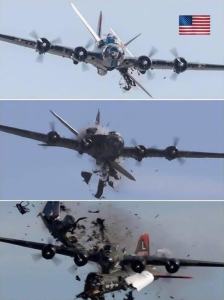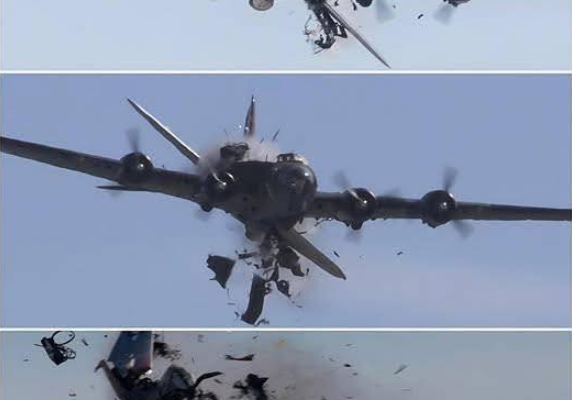
It was supposed to be a day of celebration, nostalgia, and pride. Families gathered under the clear Texas sky, waving flags and snapping photos as vintage World War II planes soared gracefully above Dallas. The annual “Wings Over Dallas” air show had always been a tribute to the nation’s aviation history — a chance for spectators to relive the golden age of flight and honor the heroes who once defended freedom from the skies. But in an instant, that joy turned into horror. What began as a showcase of skill and history ended in tragedy, as two historic aircraft collided midair, killing six beloved pilots and crew members — six heroes who dedicated their lives to keeping history alive.
The crowd of thousands stood frozen as the unimaginable unfolded before their eyes. The powerful roar of engines, once thrilling, became the sound of chaos as the two aircraft made contact. Witnesses later described seeing one plane slice into the other, both breaking apart in a fiery explosion that scattered debris across the field. Children screamed. Veterans wept. And within seconds, the sky that had been filled with pride and wonder turned into a scene of devastation and disbelief.
The crash involved two iconic aircraft: a Boeing B-17 Flying Fortress — a symbol of American strength in World War II — and a Bell P-63 Kingcobra fighter, one of the rarest planes still flying today. Both belonged to the Commemorative Air Force, a nonprofit organization devoted to preserving and flying vintage military aircraft. These were not just planes; they were flying museums, carefully restored and maintained by volunteers and aviation enthusiasts who viewed their work as a sacred duty. The men on board were more than pilots; they were historians, engineers, veterans, and dreamers who wanted to keep the memory of those who fought for freedom alive.
As the smoke rose from the wreckage, a stunned silence fell over the crowd. Emergency crews rushed to the scene, but it was quickly clear that no one aboard had survived. The six men — described by those who knew them as generous, passionate, and deeply committed to aviation — were gone in an instant. They had spent countless hours preparing for the show, walking through every maneuver, ensuring the aircraft were safe. But sometimes, even the most experienced hands can’t stop tragedy when fate intervenes.
In the hours that followed, news of the disaster spread across the nation. Videos recorded by spectators circulated online, showing the moment of impact in haunting clarity. The sight left many speechless — the midair collision, the burst of flames, the rain of debris. It was painful to watch, and yet millions did, struggling to comprehend how such a thing could happen. Federal investigators from the National Transportation Safety Board (NTSB) quickly arrived, determined to find answers. Early reports suggested that a miscommunication or a breakdown in formation spacing might have led to the deadly collision, though the final report would take months to complete.
But behind the technical questions were human stories — stories of courage, love, and legacy. Among the victims were retired military pilots and long-time airshow professionals who had dedicated decades to preserving aviation history. Many had flown combat missions or trained the next generation of aviators. They weren’t performing for fame or money; they were doing it out of passion, driven by a sense of duty to honor those who came before.
In the days that followed, tributes poured in. The Commemorative Air Force released a statement honoring the fallen as “extraordinary individuals who shared a love of flight, history, and service.” Fellow pilots called them brothers. One man said, “They died doing what they loved, surrounded by the planes they cared for and the people they inspired.” Candlelight vigils were held across Texas, where families, friends, and aviation enthusiasts gathered to mourn. Flowers were placed near the crash site, along with model airplanes, photographs, and handwritten notes that simply read, Thank you for keeping history alive.
For many, the loss struck deeply because air shows like Wings Over Dallas aren’t just entertainment — they’re living lessons. They remind younger generations of the bravery and sacrifice of those who fought in the skies during World War II. When those aircraft fly, they tell stories that books can’t capture — the sound of the engines, the smell of oil and smoke, the sight of formation flight against the blue sky. To see them fall was to lose a piece of that living history.
As investigators continued their work, questions lingered about the future of such events. Could air shows ever truly be safe? Should rare, irreplaceable aircraft still be flown? The aviation community was divided. Some argued that grounding these planes would be the ultimate loss — that their purpose is to fly, to inspire, to remind. Others urged caution, believing that the preservation of life must come first. Yet all agreed on one thing: the men who died that day would not want their legacy to end in fear. They would want people to keep flying, keep teaching, and keep honoring the stories of those who once fought for the skies.
Weeks later, when the smoke had cleared and the investigation continued quietly in the background, the airfield felt emptier. The familiar hum of propellers was gone, replaced by the echo of memories. But among the community that had lost so much, there was also resilience. The families of the fallen pilots came together, united by grief and pride. They spoke of the joy these men found in flight, of their laughter, their dedication, and their unwavering belief that history should be touched, heard, and seen — not just read.
The Dallas air show tragedy will forever be remembered as one of the darkest moments in aviation demonstration history. Six lives lost in seconds, six families forever changed, and a nation reminded of the risks that come with keeping the past alive. Yet in the shadow of heartbreak, their legacy endures. Every time a vintage plane takes to the sky, every time a child looks up in wonder, and every time someone hears the deep rumble of a radial engine and feels a surge of pride — those six heroes live on.
They were not just pilots. They were storytellers, guardians of memory, and keepers of the flame that connects past and present. Though their wings were lost that day over Dallas, their spirit continues to soar.

